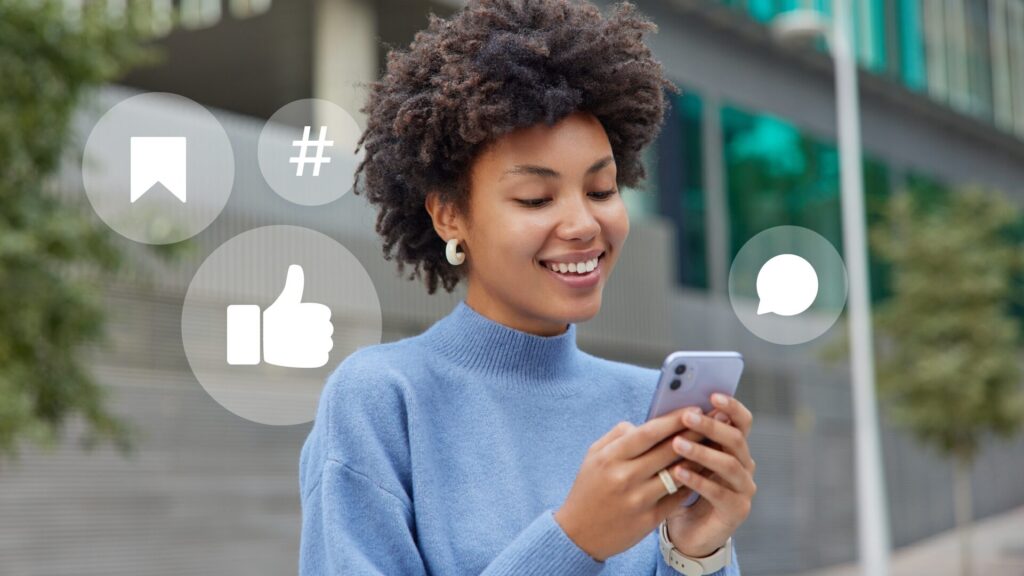Seasonal marketing: How B2B brands can win the holiday season

Holiday season. Perhaps the busiest time of year for marketers, and whilst B2B marketers aren’t quite as under pressure as ecommerce, we can still take advantage of the frenzy. The plethora of sales holidays starting with Singles’ Day on November 11, going right through to Christmas means its a time for increased sales, and B2B can absolutely get a slice of the (pumpkin) pie.
People are in buying mode, checking their inboxes more frequently, and looking for connection as much as discounts.
Why seasonal marketing works beyond retail
The holidays aren’t just for shopping, they’re also for reconnecting. It’s a great time to build an emotional connection with your audience to build on customer loyalty. This is a key time of year for engagement as your audience is checking inboxes, planning budgets, and reflecting on the year gone by.
In this blog, we’ll explore how B2B marketers can take a page from ecommerce’s playbook, adapting high-performing seasonal strategies to engage decision-makers, nurture leads, and make your brand top of mind during the most competitive time of the year.
Standout B2B holiday campaigns and what we can learn
Cyber Monday and Black Friday for B2B brands
Black Friday and Cyber Monday (BFCM) are often thought of as consumer-focused shopping events, but for B2B marketers, they represent a unique opportunity to engage clients, nurture leads, and accelerate sales before the end of the year. Business people are still people, they’re just at work, and it’s certainly a time where people are in the buying mood, so take advantage of that.
This campaign from writing assistant tool Grammarly shows that B2B can take part in traditional Black Friday style discounts. Offering its software with a huge 50% discount over Black Friday and Cyber Monday the campaign is sure to jump out in the inbox.
The huge discount and short window in which to redeem it encourages urgency, and thanks to the already established nature of BFCM sales, the ‘ending soon’ angle feels genuine rather than pushy.
Subject line: Cyber Savings start now! Get 50% off Grammarly Pro
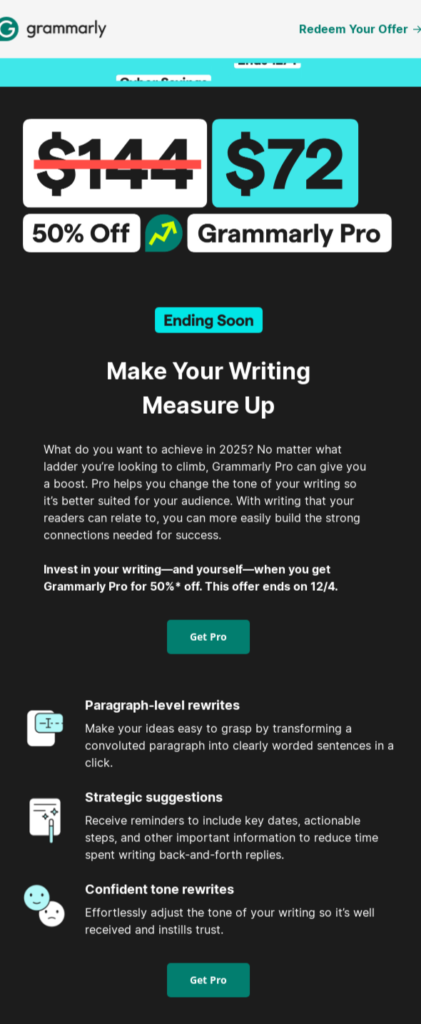
Why it worked
The email is simple, but still tells you everything you need to know. BFCM is a busy time, just last year Dotdigital sent over 365 million emails on Black Friday alone, so having your main takeaway above the fold (visible immediately without scrolling) is crucial.
The campaign makes the offer clear and then talks directly to the consumer, aligning the product to hitting your goals for the next year. Finally there’s a clear, concise overview of what Grammarly offers – making it the perfect email to simply forward on to a manager or budget holder if required.
How to replicate it
Identify something extra you can provide, while a classic discount is what customers expect over BFCM, you’re not limited to this. For many B2B brands the sales cycle is longer and more complex than a one-off purchase. Instead of offering an on-the-day immediate benefit, try offering a discount or additional benefits to customers who express interest on BFCM. Create a unique sign up form to attract new leads across social media, website, and email with this unique offer and then you have a list of engaged prospects that you can continue to close over the coming weeks.
BFCM isn’t just for ecommerce, see how charity marketers provide enticing offers for BFCM here.
End of year B2B campaign ideas
The holiday season falls at the end of the calendar year, which is nostalgic by nature. This makes it a great time to do a roundup of your year and remind your audience the value you bring, and the community they’re a part of. Connect with your audience by reflecting on the year’s achievements, thanking supporters and customers, and reinforce your brand’s values. By taking a moment to acknowledge and appreciate your audience, you can leave a positive, lasting impression that goes beyond typical marketing communications.
Find an angle that makes sense for your brand. Here are some examples from different B2B brands.
Subject line: 🗓️ The ecommerce trends you cared about most in 2024

Why it worked
Shopify took the opportunity to roundup and reshare its most popular content from the year. Both reminding your audience of all the great content you get for subscribing and getting more eyes on valuable content. It also adds to the community feeling, subtly reminding customers that they’re part of a group of like-minded Shopify fans working towards a similar goal. Plus, social proof comes in all forms. Highlighting this ‘most popular’ content makes for a great reading list.
Subject line: Celebrate the end of the year with The Drop
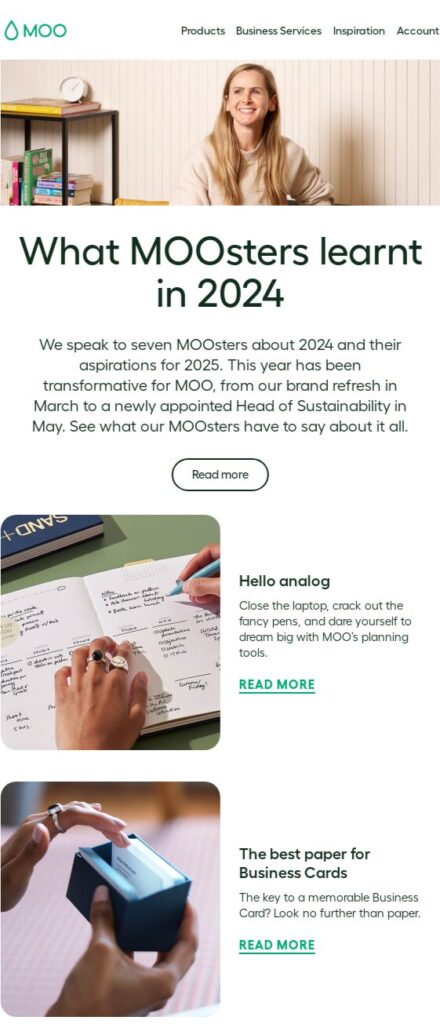
Why it worked
MOO put its team center stage, sharing a blog where employees talk about the changes the brand has experienced that year. This is a nice way to add humanity and personality to your brand and build community content.
Subject line: Everything we shipped in 2024

Why it worked
Figma took the opportunity to remind customers of all the updates they released that year to show the progression and value of being a Figma user. The email also reminisces on the successful conference, Config. Overall, the campaign is full of positive energy, reminding customers of the brand’s commitment to serving its audience and providing what they need.
How to replicate it
Think about what you’re most proud of from this year and create a campaign around that. Is it product launches, events, an award win? Whatever is worthy of celebration and of interest to your audience is best here.
Pull in some user-generated content (UGC) in the form of reviews to bring the community element into your campaign. Look at ways you can make this campaign personal to the recipient, everyone loves Spotify’s annual Wrapped campaign. Perhaps you can create a personalized campaign that pulls in personal data fields such as events attended, new features used, or similar.
You can also send the campaign from a recipient’s dedicated account manager if appropriate to give it that extra relevancy. Our 2025 loyalty report found that while 78% of consumers feel brands personalize their marketing at the right level, only 23% consider those messages to be truly relevant.
A B2B approach to holiday campaigns
A happy holiday message is a simple and effective way to strengthen relationships and show appreciation to clients, partners, and collaborators. This is your digital equivalent of a holiday card, and with Dotdigital it’s completely eco friendly as our platform is carbon-neutral.
Subject line: Happy Holidays, from our work family to yours ❤️
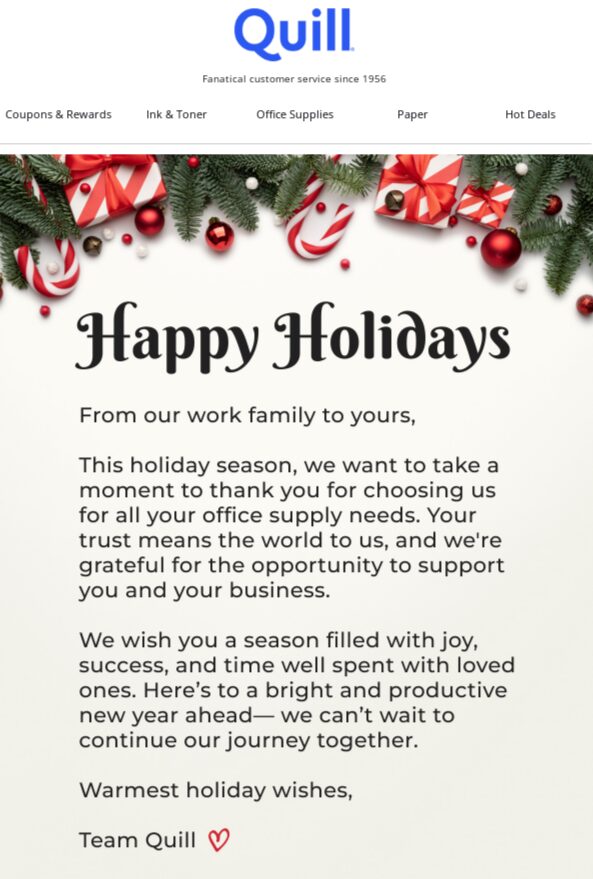
Subject line: ✨A wish from MOO to you
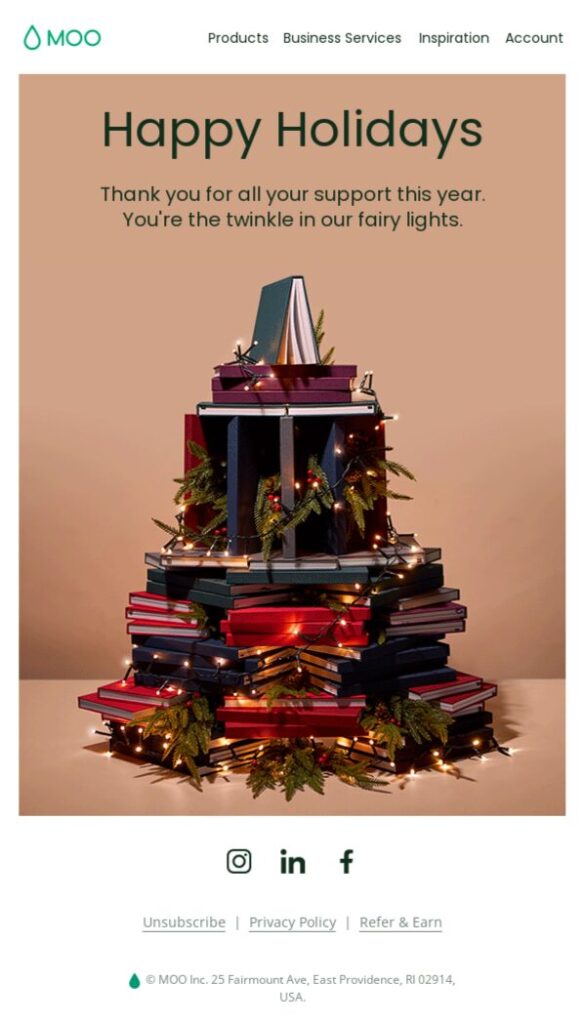
Why it worked
Unlike transactional or sales emails, a holiday greeting is personal and thoughtful, reminding recipients that your business values the relationship beyond revenue. It helps humanize your brand, foster goodwill, and keep your company top of mind as the year closes, setting a positive tone for future collaboration in the new year. Also bare in mind that not everyone celebrates the holidays and it can be sensitive for some, so give your audience the opportunity to opt out of holiday content in your preference center.
How to replicate it
These campaigns can be super simple. The Quill example shows how a heartfelt thank you can work and MOO’s simple image-led campaign with just a couple of lines of text is something you can put together quickly.
We’re all about humanizing B2B marketing, and this is a good opportunity to show the faces behind your brand. Position your message to come from someone notable like your founder or CEO, include a photo, and be sure to personalize that ‘friendly from’ name for better engagement. Segment your customers and your prospects so you can send a tailored and highly relevant message to both groups.
As this is your virtual holiday card, incorporate seasonal imagery and colors to make the design deliver on the warm and fuzzy feeling. Just remember to send this before Christmas week to avoid your email being missed as people log off from work for the holidays.
So, can B2B brands win at seasonal marketing?
Absolutely. Stake your claim in the busy holiday inboxes by offering something different, yet just as exciting. By taking on traditional sales days and tactics with a slight reposition to suit your brand, you can provide relevancy, build emotional connection, and share positive energy to round out your year and set the tone for the next.


